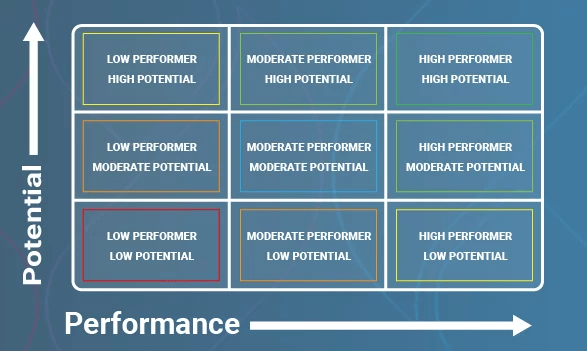A 9-box grid is a tool that is widely used in HR to help facilitate conversations about employee development and succession planning. Employees are mapped against two axis, typically current performance and future potential. Historically, the focus was on leadership, but the grid was quickly adapted for use with other groups of employees, such as those with specialist skills that might be critical to the business, like analysts or programmers, or sharing common characteristics, such as graduates. Nowadays, most HR systems include integrated nine-box grids that enable a more agile and inclusive approach to talent planning and development.
How does it work?
HR and managers work together to assign employees to relevant boxes on the grid based on the two categories. The x-axis represents the employees’ current overall performance, and the y-axis represents their potential, a prediction of their future performance.
While the conversation needs to be informed, the process is by its nature iterative. Insight into the current performance or future potential of one employee may shift the thinking about another. Discussions about organisational objectives or the competitor landscape, could lead to different perspective on the value of current skill sets or aptitude in the future.

What are the benefits?
Encourages dialogue
As an HR professional, you’ll understand the difficulties of assessing employees’ performance and evaluating the health of different talent pools within your company so that you can help plan for business continuity and employee growth. How does the business go about rating your employees’ potential? How do you identify who will make a strong future leader, and do you know who is falling behind?
This is where the 9-box grid can help. It’s a simple, but visually powerful tool that serves as a framework for discussion with managers about talent and encourages important conversations that are unlikely to happen without it. It allows managers to collectively identify the strengths and weaknesses in their talent pool, whilst giving transparency over the state of the talent across the whole company, helping to remove barriers to employee movement.
You get a fresh perspective
Because the process of assigning employees to different parts of the grid is collaborative, managers benefit from hearing the opinions of others, so that a more objective assessment of employees’ progress and potential can be made.
Perhaps a manager’s relationship with an employee has biased their assessment of his/her performance. Or maybe an employee demonstrated abilities their manager wasn’t aware of when collaborating on a project with a different team. Having a collection of opinions brings fresh perspectives for everyone involved, allowing for a more informed discussion.
Helps you plan for the future
The process doesn’t stop with a constructive conversation however. The real value is in how you use the information to improve succession planning and employee career development, so you can ensure the continuity and growth, and take your business to the next level.
For example, those employees identified as having high potential and high performance and showing signs of being future leaders, or future stars in their own right, will need to be nurtured so they remain challenged and rewarded. Maybe they’re the ones who will be integral to the success of an upcoming project or fill the shoes of a manager who has left.
Some of the weaker players in your cohort, or those who aren’t suited to their current role, can also be highlighted in this process. High potential but low performance employees may need motivating, perhaps by a stretch assignment, mentoring or a change in position within the company; candidates consistently assigned to the low potential and low performance box will need a different strategy. Should they be dropped from the grid altogether, and if so what are the implications for their future growth within the company?
What are the downsides?
Not everyone is a fan of the 9-box grid. There are concerns about the validity of measuring ‘potential’ as a category, many considering it to be too closely linked with ‘performance’. After all, it’s rare an employee would measure well for potential whilst their performance is poor, for instance. Because of this some organisations have replaced potential with other measures, such as agility or aptitude for change.
Some also worry that assigning employees into categories promotes employee labelling which then becomes difficult to unstick, and managers use these labels as shortcuts when discussing employees. If an employee is assigned to the bottom left corner of the grid, for example, they’re considered a weak employee, and it could be difficult for them to shake this label.
These are valid concerns of course. However, research by leadership institute, Roffey Park, suggests that these challenges can be overcome.
If managers clearly discuss and define how they will measure potential from the outset and also use the grid fluidly so that employees don’t get permanently pigeon-holed, it remains an effective tool for encouraging discussion.
When it comes to using a 9-box grid, it’s vital that HR and managers establish what they want out of the process before they start, ensure they act upon the discussion generated from the process, and don’t just use the grid for the sake of it.

Drag and drop employees to produce a real-time view of your organisation’s talent with Cezanne HR’s configurable 9-box grids
Chris Wells
A graduate of the University of Birmingham, Chris is an experienced marketing manager who now works for prestigious publishing firm HarperCollins.


